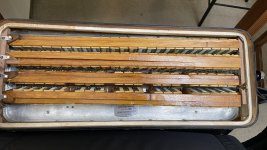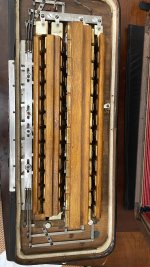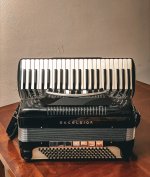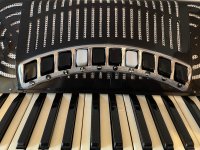This is the standard Symphony Grand reed configuration LMMH on the right hand and 6 sets of reeds on the left hand. The right-hand reed blocks you see in the top photo have the following arrangement (in the same order as shown in the photo):
H - white keys
M - white keys
L - white keys
M - white keys
H - black keys
M - black keys
L - black keys
M - black keys.
Hi Alan,
Thanks for Clarifying!
Your answer matches with what Tony told me (a 4/6 reed configuration) makes sense to me, since the number of reeds that appears on those reed blocks approximately match with the number of black and white keys.
Although can you explain why there are 19 reeds on the reed blocks for black keys, but on the keyboard there are only 18 keys? on the contrary, there are 24 reeds on the reed blocks for white keys, while on the keyboard there are 25 keys. Is it possible that the additional reed on 'black-key' reed blocks is for white keys?
As I asked in response to Henry, I also wonder how did you tell the number of reed blocks/sets on left hand? 6 sets make sense to me, since each 'side' of a wood block include 12 reeds, which is the number of diatonic keys on bass.
If you are right about the 4/6 reed configuration of my model, then it is possible that:
1. my model is essentially a
Black Excelsior Symphony Grand 41 keys 4/6 LMMH, except that: a. mine does not have the mute switch, b. has two additional keys, c. has a different look on grill
If Henry was right that it is a 4/5 LLMM, then it is possible that:
my model is essentially a
Black Excelsior Symphony Grand 43 key 4/5 LLMM, except that: mine is 120 bass instead of 140 bass.
A third possibility is that my model is LLMM on the treble, and has 6 sets of reeds on bass, which makes a 4/6 LLMM. This means either I am having a very rare model not listed much, or that the listing of
Black Excelsior Symphony Grand 43 keys 4/5 LLMM is incorrect, and should actually be 43 keys 4/6 LLMM.
With all these possibilities, we need historians who knows what has been produced by Excelsior in 50s!
Thanks!




